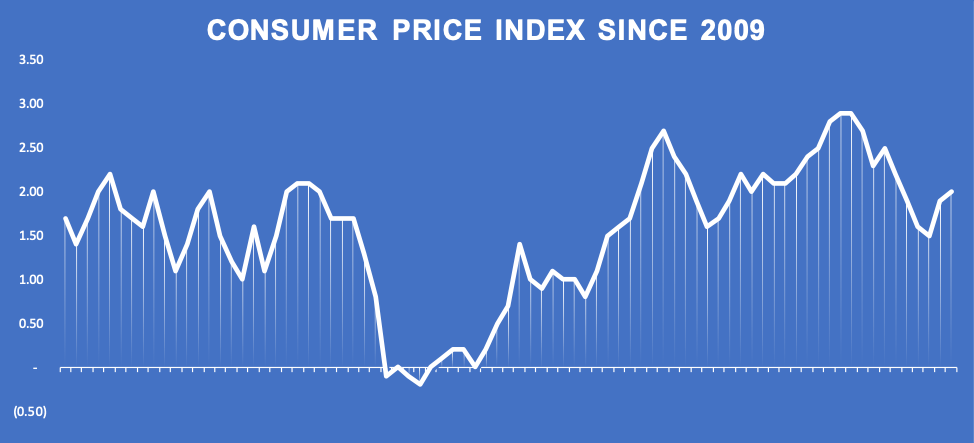By Rick Patelunas
For many people, when they hear about the Consumer Price Index (CPI), their eyes glaze over and they begin to nod off. But don’t let the graph lull you to sleep. You need to pay attention.
Why?
CPI can be used as a sneaky way to cut programs without drawing much attention, which is what the Trump administration is doing right now. The Administration proposed changing the CPI measure for poverty to Chained-CPI. The Nation magazine reports that “using the Chained CPI would mean more than 300,000 children would lose access to Medicaid or the Children’s Health Insurance Program (CHIP), and more than 250,000 seniors and people with disabilities would lose help paying for Medicare health coverage. Millions fewer people would be able to take advantage of lifesaving programs.”
And that’s only a small part of the picture. The Bureau of Labor Statistics (BLS) publishes the CPI each month and the BLS reports that CPI “affects the income of almost 80 million people as a result of statutory action” including:
- 8 million Social Security beneficiaries.
- About 4.1 million military and Federal Civil Service retirees and survivors.
- About 22.4 million food stamp recipients.
- The cost of lunches for the 26.7 million children who eat lunch at school.
Those BLS numbers include hundreds of thousands of our neighbors who are affected by the CPI. In the 7th Congressional District, the CPI affects the benefits of nearly 200,000 Social Security recipients. In Horry County, the Trump proposal would cut benefits to many of the 17 percent who earned less than the poverty level during 2018, including 22 percent of the employed who lived in poverty.
Understanding CPI
There are several variations of CPI that serve different purposes, but each one compares the price of a basket of goods over time. The basket consists of food and beverages, housing, apparel, transportation, medical care, recreation, education and communications, and other goods and services. For example, if the basket of items cost $100 in May and $110 in June, inflation was 10 percent.
Although there are several variations of CPI, the differences are clearly defined. The differences are adjustments to the basket of goods used by the BLS.
• CPI-U is the most well-known inflation measure in the US. CPI-U covers nearly the entire population and measures the basket of goods for urban wage earners and clerical workers, professional, managerial, and technical workers, the self-employed, short-term workers, the unemployed, retirees and others not in the labor force.
• In 2002, the BLS started reporting Chained-CPI. The difference between CPI-U and Chained-CPI is that Chained-CPI substitutes less expensive items in the consumer’s basket. Say that the price of pork goes up, less expensive beef is substituted for pork in the basket. Meat is still in the basket, but the price of the entire basket doesn’t increase as much. Replacing higher priced pork with lower priced beef lowers the inflation index, which can reduce benefit payment adjustments.
• In 2012, CPI–E was introduced to measure inflation on the elderly. The difference between CPI-U and CPI-E is the basket of goods for the elderly is different. Elderly spending patterns are not the same as the general population. For instance, older people spend relatively more on items like prescriptions and healthcare, so the basket of goods for the elderly is adjusted for prescription and healthcare expenses. If healthcare costs are rising more than apparel and recreation, inflation is greater for the elderly than the typical consumer.
Congressman Rice Reacts to CPI Questions
Congressman Tom Rice would have us think that we can’t understand CPI. CPI and Social Security were the first topics of discussion at a Coffee with the Congressman on April 10, 2017 at J.L. Leonard’s Restaurant in Garden City. That morning, the Sun News printed a letter to the editor from me urging Rice to support changing the calculation of Social Security Cost of Living Adjustments (COLAs) to CPI-E:
CPI-E is the clear choice for Social Security reform. Rep. Tom Rice has said Social Security needs reform, and I sat in on his phone-in town hall during which he voiced concern for the elderly in our district. The CPI-E Act of 2017 is the chance for Rice and other members of Congress to make a lasting contribution to the well-being of Social Security beneficiaries.
As Mr. Rice introduced himself around the room, I handed him a copy of the paper and said there is a letter to the editor that he should read. I meant that it should be read sometime after the event, but the first question of the morning was from a woman who read the letter from her phone. She then asked Rice what he was going to do about Social Security.
The Congressman tried to explain, but he used the wrong version of CPI in his response. When I corrected him from the audience, he dismissed his mistake with something along the lines of: Who understands all those numbers?
Well, Mr. Congressman, we do.
Where Do You Stand, Congressman Rice?
Rice has yet to state his position on CPI for Social Security COLAs or to measure poverty. The welfare of hundreds of thousands of people throughout the 7th District hang in the balance.
So, does he think Social Security COLAs should be cut with Chained CPI or expanded with CPI-E?
The Congressman is a virtual blind supporter of President Trump. Does he support using Chained CPI to cut the benefits of hundreds of thousands in poverty?
Ask Congressman Rice his position on CPI by contacting him: https://tomriceforms.house.gov/contact/ or his office locations found at: https://rice.house.gov/office-information.
It’s time to Take a Stand.
Image: Bureau of Labor Statistics, U.S. Department of Labor, The Economics Daily, Consumer Price Index increased 2.0 percent for year ending April 2019 on the Internet at https://www.bls.gov/opub/ted/2019/cpi-increased-2-point-0-percent-for-year-ending-april-2019.htm (visited June 09, 2019).




